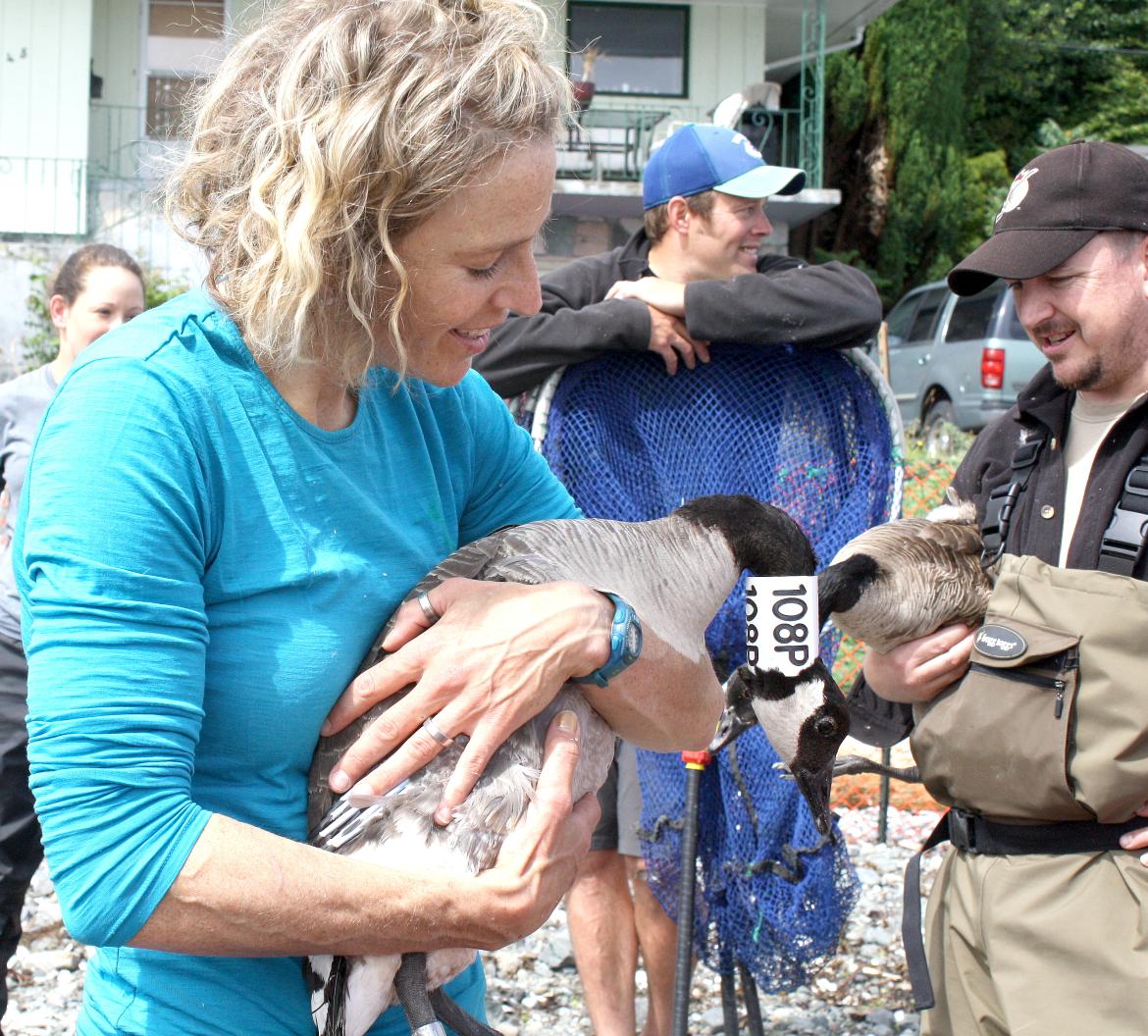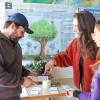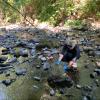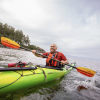
VIU biology technician Wendy Simms prepares to release a freshly collared Canada Goose with Nanaimo Environmental Protection Officer Kevin Brydges (right) and VIU undergraduate researcher Stew Pearce.
July 6, 2016 - 8:45am
VIU biology student is asking the public to report goose sightings on a website as part of his undergraduate research project.
With the help of an intrepid group of volunteers and the City of Nanaimo, Vancouver Island University (VIU) biology student Stew Pearce was able to successfully collar and band 200 Canada Geese as part of an undergraduate research project to evaluate their abundance, distribution and movement around Nanaimo.
The geese now sport highly visible white collars around their necks that display three numbers and the letter ‘P’. While Pearce will be working to monitor their movements well into wintertime, a website has been set up for the public to help by reporting the date and location of collared goose sightings, along with the information displayed on the collar.
“Without the website the general public wouldn’t be able to report when they see the collared birds so we really want to get the word out that there is a website for them to do that,” said Pearce. “The information will be used to generate maps showing the movements of the geese within Nanaimo and beyond. With the public’s help we will be able to add the data they provide to our other monitoring efforts which will be used to inform future management plans.”
To get the collars on the feisty birds, volunteers in canoes and kayaks round up the geese and herd them onto beaches and into pens constructed of orange snow fencing. It was all done over two weeks in June at various spots around Nanaimo including Departure Bay, Piper’s Lagoon, and the Nanaimo River estuary.
“We have to band them when they’re moulting, right after the breeding season. That’s when they lose all their flight feathers. They don’t grow back for around 10 days so if we don’t get them in that short window, they will just fly off when we try to round them up,” said Pearce. “We wouldn’t have reached our target of 200 birds without the incredible volunteers who came out to help. It takes a lot of manpower to get geese corralled and to keep them in the pens for banding, so I’m really grateful to them for their help.”
VIU biology professor Dr. Eric Demers is supervising the project. He says Canada Geese are not native breeders on Vancouver Island. The birds that are here year-round are descendants of geese that were introduced in the 1970s in an effort to improve wildlife viewing and sport hunting opportunities on the Island.
“Often when a species is introduced into an ecosystem there are unintended consequences to that action and that is the case here,” said Demers. “In the almost 50 years since they’ve been here populations have exploded across the Island. Canada Geese are responsible for overgrazing and habitat degradation of freshwater and saltwater wetlands as well as agricultural lands. They contribute to increased health risks due to contamination of drinking water, fouling of beaches and public parks.”
For those reasons, the City of Nanaimo has been trying to control Canada Geese populations for more than a decade. Kevin Brydges is the Environmental Protection Officer for Nanaimo. The City of Nanaimo is partnering with VIU on the project by providing collars, snow fencing and equipment as well as technical support. He says many communities across Vancouver Island are working on their own management plans including Victoria, Parksville, Port Alberni and Campbell River. Together they are in the process of forming a regional management committee to share information and work together on the issue.
“They are pests and very difficult to control. Because they like eating freshly mowed grass they use our parks, cemeteries, schoolyards and beaches as roosting and feeding areas, which brings them into conflict with people all the time,” said Brydges. “We are thrilled to be able to partner with VIU on this project because the data that is collected will help us define a long term, regional approach to managing geese populations.”
Pearce wants to remind people that Canada Geese can be aggressive, so if you see a collared goose and can’t immediately see the numbers stamped on the collar, stay a safe distance away and never try to touch or handle the birds. The use of a camera-zoom or binoculars can be helpful to view the collar information.
To report a sighting, please go to VIUGooseProject.
-30-
MEDIA CONTACT:
Dane Gibson, Communications Officer, Vancouver Island University
P: 250.740.6288 | E: Communications@viu.ca T: #viunews
Tags: Research






